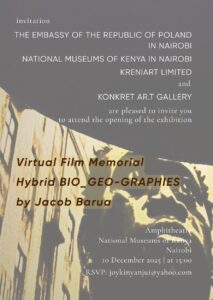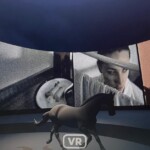“Art, memory, and technology intertwine in the new work by Jakub Barua, combining film, virtual reality, and reflections on identity.“
The Virtual Film Memorial. Hybrid BIO_GEO-GRAPHIES of Jacob Barua project creates an immersive, interactive artistic experience that brings together memory, identity, and intercultural dialogue between Poland and Africa. The virtual environment, inspired by Barua’s poetic and visual imagination, becomes a space of emotional and intellectual engagement, connecting generations and continents.
“Jacob Barua’s BIO_GEO_GRAPHIES is an artistic record of movement — between continents, languages, memories, and identities. A selective virtual archive of Barua’s artworks and poetic map of belonging, intertwining Poland and Africa, art and technology, past and future.”
— Aleksandra Łukaszewicz, curator
Artist: Jakub Barua
Curator: Prof. Aleksandra Łukaszewicz
VR producer: Jacek Nagłowski
In collaboration with: Prof. Karina Banaszkiewicz-Sadowska
The Virtual Film Memorial will be presented in situ at the Amphitheatre at the National Museums of Kenya in Nairobi and via a dedicated link here starting from the 10th of December 2025 at 15:00 EAT.
The Virtual Film Memorial is part of the wider Programme consisting of the following events:

4 December 2025 – Film Retrospective, Kenyatta University
Films featured: Shades of Poland (1999), The Welcoming (1990), My Daddy Was a Cavalryman (2006), Forgotten Places (1993), In Memory of Me (1990), This-That (1989). Please scroll down to explore the synopses of the films below.
10 December 2025 – Exhibition Opening, National Museums of Kenya
Presentation in VR (MetaQuest headsets) and spherical projection, reaching students, young filmmakers, and the general public.
Accompanying Publication – Biography as a Space for Dialogue between Polishness and African Cultures. Jacob Barua – Man of the Third Culture
Edited by Karina Banaszkiewicz-Sadowska
Contributors: Karina Banaszkiewicz-Sadowska, Aleksandra Łukaszewicz, Rainer Leimeroth, John Geofrey Mugubi, Rachel Diang’a
Publication planned for late 2026
This project was funded by the Embassy of the Republic of Poland in Nairobi and within the research framework of the Polish Society for Aesthetics under the CAPHE project, financed by the European Union’s Horizon Europe programme (Grant No. 101086391). The views expressed belong solely to the authors and do not necessarily reflect those of the European Union or the European Executive Agency.
The production of the virtual exhibition was funded under agreement No. 1/07/2025 between the Embassy of the Republic of Poland in Nairobi and KreniArt Limited.

Biography of Jacob Barua
Jacob Barua — film director, screenwriter, producer, photographer, actor, musician, poet, painter, and columnist — was born in 1967. He graduated in Film and Literature Studies from the University of Warwick (1989) and also studied directing at the Leon Schiller National Film, Television and Theatre School in Łódź (PWSFTViT).
His most notable films from the years 1989–2020 include This-That (debut, 1989), Shades of Poland (1999), My Daddy Was a Cavalryman, In Memory of Me, Forgotten Places, World Flight 1997, No Limits, Candlelit Landscape, and Taking Action. He is currently working on two major projects: Last Parade, based on the memories of Kenyans who fought in the British Army during World War II, and the third part of his trilogy about Polish Siberian deportees and refugees.
Between 2005 and 2007, the director of This-That also served as the Director of the Zanzibar International Film Festival (ZIFF).
Jacob Barua has become one of the pioneers of Kenya’s modern national cinema and has developed a new model of documentary filmmaking. For more than 30 years, his work has offered a profound look at the human experience while fostering lasting cultural ties between Poland and Kenya.
Curator Aleksandra Łukaszewicz in conversation with Bogna J. Gladden-Obidzińska:
Synopses of the films featured during the Retrospective
1999 – SHADES of POLAND (Polskie Odcienie)
A documentary produced by Polish Television 1 (TVP1), directed by Jacob Barua, with cinematography by Stan Barua.
A fascinating journey through the shared history of Poles and the peoples of Africa — a story that begins with the symbolic gifting of the spear of St. Maurice of Africa to the Polish prince Bolesław Chrobry as a royal insignia, and unfolds through the parallel experiences of enslavement and struggles for independence in both regions. The journey culminates in the present day, with scenes from the life of a young English teacher from Africa, her husband who runs an African art shop, lessons in a Polish school, and a rehearsal of the Polonaise in which their daughter also takes part.
1990 – THE WELCOMING (Powitanie)
Produced at the National Film, Television and Theatre School in Łódź (PWSFTViT), directed by Jacob Barua, with cinematography by Stan Barua.
The Welcoming is a childhood memory and a portrait of the inner world of a young man who, in a courtyard in Łódź, first welcomes himself according to an African ritual and then bids farewell to the spirit of his ancestor. The retrospective structure weaves together images of a boy solving a geography riddle and dreaming, with childlike wonder, of far-off journeys. At the core of the narrative, the African youth completes the final farewell to the deceased and explains the traditions of his distant continent to the onlookers in the courtyard — and to us, the viewers. Attentive audiences will also notice a quotation from Joseph Conrad’s Heart of Darkness embedded within the film.
2006 – MY DADDY WAS A CAVALRYMAN (Mój tatuś był ułanem)
A documentary film produced by Polish Television Channel 1 (TVP1), directed by Jacob Barua, cinematography by Stan Barua.
An extended in-depth interview — a record of childhood memories, reflections on Poland and Kenya, and the life story of a woman who, together with other Poles, was cast by the Second World War onto the shores of East Africa, at the gates of Mombasa, and who ultimately found her home and place in Kenya.
The film was censored in Poland, and its broadcast was banned for ten years. It was aired for the first time on TVP1 only after the young director left the country, and the Polish authorities of the time declared the end of any further collaboration on his future projects.
1994 – FORGOTTEN PLACES (Miejsca zapomniane)
A pioneering Kiswahili film, Polish–Kenyan co-production, directed by Jacob Barua, cinematography by Stan Barua.
A legendary film shot in the Swahili language. The director offers a sweeping vision of the history of Kenya’s coast and its people, creating a myth of the great flood and inviting viewers to believe that a cataclysm consumed the abandoned towns. He builds the narrative from hypnotic images of nature and human life, from legends drawn from around the world, and from landscapes interwoven with the people who inhabit them. He constructs the myth of the deluge and carries the viewer along with its captivating, dreamlike vision.
1990 – IN MEMORY OF ME (Na moją pamiątkę)
Produced and directed by Jacob Barua, cinematography by Stan Barua and Steven Makau; production consultant: Jam Karanja.
A study of the identity of its protagonist, Prince Eustachy Sapieha. The history of his family begins in Lithuania, in the Polish–Lithuanian Commonwealth, and for more than 500 years, their fate has been intertwined with that of the Commonwealth and of Poland itself. His ancestors and descendants have remained devoted to their Polish identity despite migrations, political upheavals, and systemic changes.
In his Polish home in Nairobi — a Lithuanian by paternal line and a Pole at heart — he begins work on a book about the Sapieha family history, typing out words in memory of himself and of the Sapiehas: noblemen, émigrés. In short, in memory of people who feel and cultivate Polishness in the world, even when geopolitical maps deny them the right to be called Polish.
1989 – THIS–THAT (To–Tamto)
Co-produced by Jacob Barua and Constantine Gras, directed, written, and cinematography by Jacob Barua.
This is the director’s first film, already revealing his unconventional and painterly style. It tells the story of a mysterious student who returns to the university, haunted and marked by the vision of a Greek legend: Icarus rising toward the sun. Is this mad ascent beyond reality still an experience accessible to humans in our times?










